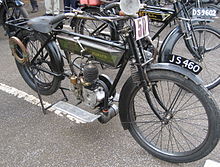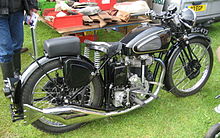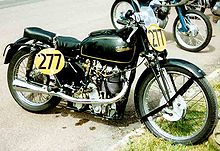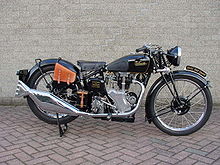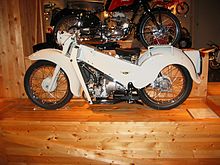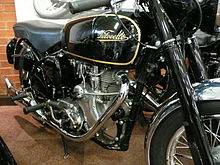- Velocette
-
Velocette 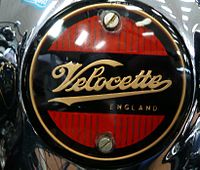
Industry Motorcycle Fate Voluntarily liquidated Predecessor Veloce Ltd Founded 1904 Founder(s) John Goodman Defunct 1971 Headquarters Birmingham, United Kingdom Key people John Goodman, Eugene Goodman, Percy Goodman Products Motorcycles Velocette is the name given to motorcycles that were made by Veloce Ltd, in Hall Green, Birmingham, England. One of several motorcycle manufacturers in Birmingham, Velocette was a small, family-owned firm, selling far fewer hand-built motorcycles than the giant BSA, Norton or Triumph concerns. Renowned for the quality of its products, the company was "always in the picture" in international motorcycle racing, from the mid-1920s through the 1950s, culminating in two world championship titles (1949–1950 350 cc) and its legendary and still-unbeaten 24 hours at 100 mph (161 km/h) record. Veloce, while small, was a great technical innovator and many of its patented designs are commonplace on motorcycles today, including the positive-stop foot shift and swinging arm rear suspension with hydraulic dampers.[1]
Contents
Foundation
The company was founded by John Goodman (born Johannes Gütgemann and later known as John Taylor before formally changing his name to Goodman) and William Gue, as "Taylor, Gue Ltd." in 1905. Its first motorcycle was the Veloce. Later that year, John Taylor set up Veloce Limited, to produce cycles and related products and services. Veloce Ltd initially produced four-stroke motorcycles. The first two-stroke, built in 1913, was called a Velocette. This name was used for all subsequent models.[2] He was joined in 1916 by his sons Percy and Eugene Goodman.[1]
Velocette two-strokes
Between 1913 and 1925, Veloce produced expensive, high-quality two-stroke motorcycles of (nominally) 250 cc, which gained an excellent reputation, and which were entered in competitions, such as the Isle of Man TT, with some success. The single-cylinder machines had many advanced features, such as a throttle-controlled oil pump, which set them apart from other manufacturers' products. The factory gradually developed this machine from the "A" series and variants (A, AC2 - coil ignition, two-speed gearbox, AC3 – three speed gearbox, etc.), then the "H" series, the model U and variants, culminating in the model GTP in 1930, which was produced until 1946. The GTP was a reliable lightweight motorcycle with good steering and power delivery.
Velocette 'K' series
In the early 1920s, Veloce realized that in order to grow as a company, it needed a new machine of advanced specification and developed an overhead camshaft (OHC) 350 cc engine, which became known as the 'K' series, introduced in 1925. After a year of teething troubles with this new design, Veloce entered the model KTT into racing events such as the Isle of Man TT and Brooklands races, and the reliability and sweet running qualities of their new engine led to a long string of racing successes. The roadster models developed from this initial model K were the Velocette KSS (super sports), KTS (touring sports), KTP (twin exhaust ports), KN (normal), and a few variations. The OHC engine series continued for roadsters until 1948, when the final KSS versions were produced, with rigid frames and Dowty air-sprung telescopic forks. Accurate valve timing was accomplished through the pioneering use of stroboscopic lamps (see timing light). The 'K' series showed an excellent turn of speed and reliability and soon the factory developed racing models to compete in the Isle of Man TT.[1]
Velocette 'M' series
In 1933, the company decided to introduce a new line of overhead valve (OHV) machines, in order to cut production costs and make a more affordable motorcycle. The K series was expensive to produce, requiring selective hand assembly of the shaft-and-bevel camshaft drive; it was determined that a simpler OHV design would be quicker to build and require less skilled labour to assemble. The first of these new machines was the MOV, using a 250 cc engine of 'square' dimensions (68 mm bore x 68 mm stroke). It was an immediate sales success, having lively performance for the time (78 mph/126 km/h), and proved a reliable machine with excellent road manners. From this machine, by lengthening the stroke of the crankshaft, the Velocette MAC 350 cc was introduced in 1934. It proved even more popular than the MOV, and became a real money spinner for the company, bringing much needed capital into the firm. In 1935 an entirely new machine was introduced, based on the two previous OHV models, the Velocette MSS of 500 cc. A new, heavier frame was utilized with the intention that the machine could serve as a sidecar hauler. This new frame was developed from the mkV KTT racing machine, and was shared with the KSS MKII of 1936–1948. The MSS also proved very popular and profitable for Veloce.[1]
Post war
After the Second World War, the company sought to capture what it saw as a developing need for personal transport and created the LE model (for "Little Engine"). This was a 149 cc water-cooled flat-twin with side-valves, a pressed steel frame and telescopic forks and swingarm. Velocette's Director, Eugene Goodman, planned an innovative and radical design that would appeal to a new market that needed cheap, clean and reliable transport. Designer Charles Udall developed the Velocette LE as a "conceived-as-a-whole" design, with engine, gearbox, drive shaft and bevel box in a single unit to do a specific job. It was sophisticated and expensive. Unfortunately it proved less successful than the firm had anticipated, and although it became Veloce's best selling model ever, the massive tooling costs for this all-new machine were barely recouped. It did see widespread adoption by British police forces for urban patrol. At the time Metropolitan Police Officers on foot patrol were required to salute sergeants and inspectors. With the introduction of the Velocette LE, this became dangerous, requiring the officer to take his hand off the handle bars, and so the rider was to allowed to show his respect with a smart inclination of his head, or to put it another way, to give a smart nod. It has been suggested that Velocette LEs became known as "Noddy Bikes".[1] However, Noddy (the popular cartoon character created by British children's author Enid Blyton) who famously had frequent run-ins with the Policeman Mr. Plod, is also credited with being the origin.
At the 1947 TT, the company won the first four places in the Junior race, and in 1950 they were the 350 cc World Champions.[3]
In 1960, Velocette introduced the Viceroy, a very unusual 250 cc opposed twin two-stroke scooter. Unique to the Viceroy was the front mounted twin-cylinder engine, and the fuel tank mounted under the front legshield. The engine itself was extremely compact, and connected to the rear-mounted clutch and transmission by a drive shaft from the engine-mounted flywheel. With electric start, 12-volt electrics, a very low centre of gravity, power over 15 hp (11 kW) and a reported comfortable cruising speed of 65 mph (105 km/h), performance, handling and features of the Viceroy were first class. Unfortunately the scooter came as market forces and rider preferences were changing, and the Viceroy was not a sales success. The late 1960s were the last years of production for Velocette motorcycles, production for the Velocette Viper and Vogue ending in 1968, "Special", Scrambler and Endurance in 1969, and MSS Venom and Velocette Thruxton in 1970. Veloce Ltd. closed in February 1971.[1]
In 1961 a Velocette Venom became the first motorcycle to cover over 2,400 miles (3,900 km) in a 24-hour period, averaging 100.05 mph (161.01 km/h).
See also
- List of Velocette motorcycles
References
- ^ a b c d e f De Cet, Mirco (2005). Quentin Daniel. ed. The Complete Encyclopedia of Classic Motorcycles. Rebo International. ISBN 13: 978-90-366-1497-9.
- ^ "Velocette". Is-it-a-lemon.com. http://www.is-it-a-lemon.com/modules.php?name=News&file=print&sid=791. Retrieved 2006-12-20.
- ^ History of Velocette Classic Motor History
External links
British motorcycle manufacturers Current Defunct ABC (1919–1923) · Abingdon (AKD) (1903–1925) · Advance (1905–1947) · AER (1937–1940) · AJW (1928–1976) · AJS Motorcycles Ltd (1909-2000) · Ambassador (1946–1964) · Ariel (1902–1970) · Armstrong (1980–1987) · Ascot-Pullin (1928–1930) · AMC (1937–1966) · Baker (1927–1930) · Bat (1902–1926) · Baughan (1920–1936) · Beardmore Precision (1914–1930) · Blackburne (1913–1922) · Bradbury (1902–1924) · Brough (1908–1926) · Brough Superior (1919–1940) · BSA (1919–1972) · Calthorpe (1909–1939) · Chater-Lea (1900–1936) · Clyno (1909–1923) · Corgi (1946–1954) · Cotton (1918–1980) · Coventry-Eagle (1901–1939) · Coventry-Victor (1919–1936) · DMW (1945–1971) · DOT (1908–1978) · Douglas (1907–1957) · Dunelt (1919–1935) · Duzmo (1919–1923) · EMC (1947–1977) · Excelsior (1896–1964) · Francis-Barnett (1919–1966) · Greeves (1953–1976) · Haden (1912–1924) · Healey (1971–1977) · Hesketh (1981–1988) · Humber (1898–1930) · HRD (1922–1928) · Ivy (1911–1934) · James (1902–1966) · JAP (1903–1939) · Levis (1911–1939) · Martinsyde (1919–1923) · Matchless (1899–1966, 1988–90) · McEvoy (1926–1929) · Montgomery (1902–1939) · Ner-a-Car (1921–1926) · New Hudson (1903–1958) · New Imperial (1901–1939) · Norman (1935–1963) · Norton-Villiers (1966–1972) · Norton Villiers Triumph (1972–1978) · NUT (1912–1933) · OEC (1901–1954) · OK-Supreme (1882–1940) · P&P (1922–1930) · Premier (1908–1921) · Panther (1904–1967) · Quasar (1975–1982) · Quadrant (1901–1928) · Raleigh (1899–1967) · Rex-Acme (1899–1933) · Rickman (1960–1975) · Rover (1902–1924) · Royal Enfield (1893–1971) · Rudge (1911–1946) · Scott (1908–1965) · Silk (1976–1979) · Singer (1900–1915) · Sprite (1964–1974) · Sun (1911–1961) · Triumph (1885–1983) · Sunbeam (1912–1964) · Velocette (1904–1968) · Villiers (1898–1966) · Vincent-HRD (1928–1959) · Wilkinson (1911–1916) · Wooler (1909–1954) · Zenith (1905–1950)Categories:- British brands
- Companies established in 1905
- Companies disestablished in 1971
- Motorcycle manufacturers of the United Kingdom
- Defunct motor vehicle manufacturers of the United Kingdom
- Velocette motorcycles
Wikimedia Foundation. 2010.

